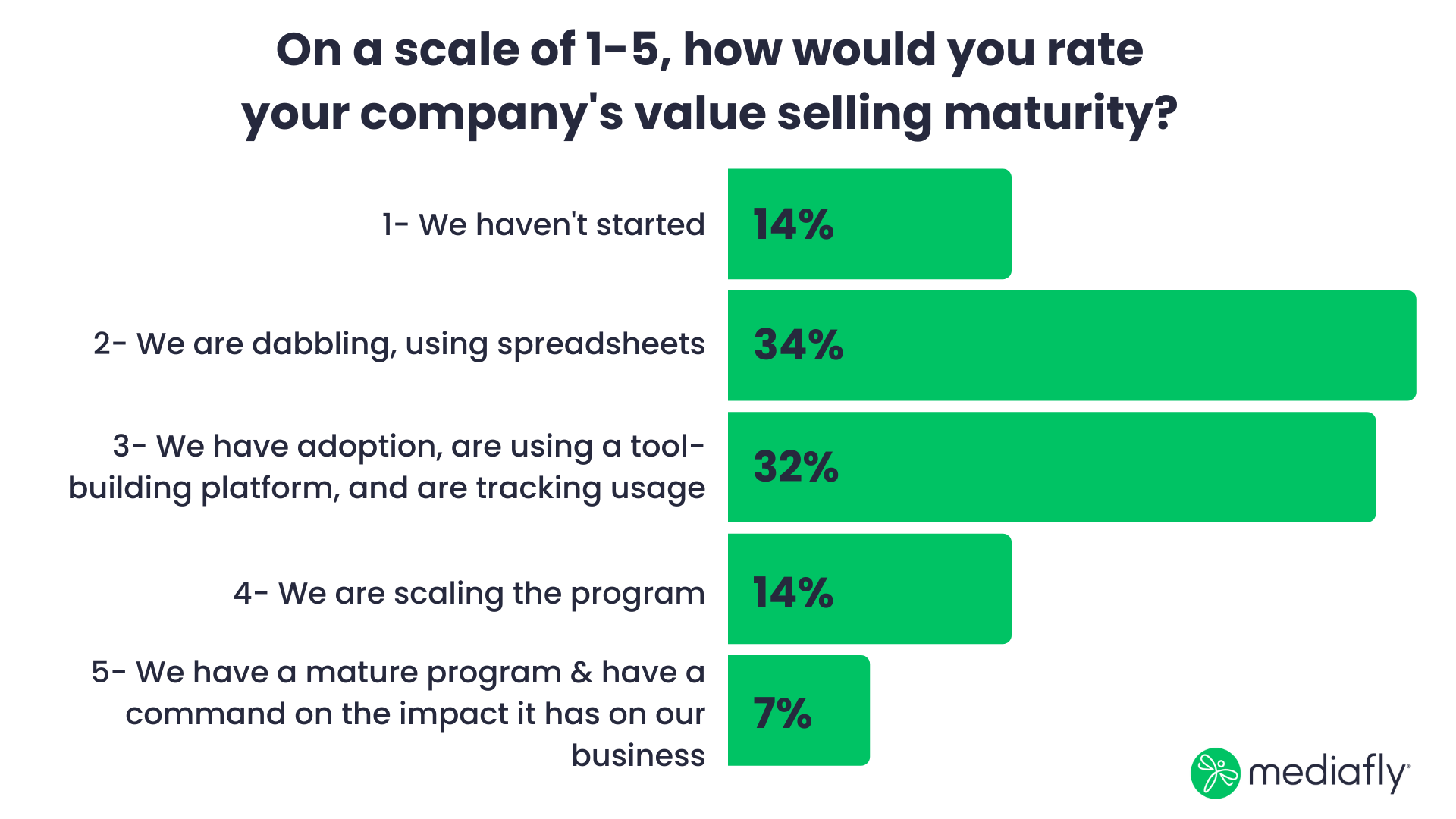Value selling is a crucial strategy for businesses looking to establish long-term relationships with their customers and break through the dreaded no-decision. However, it’s not always easy to execute effectively. That’s why we’ve turned to some of the top value-selling experts. Michelle Bai (Head of Analytics and Value, Digital Strategy Group at Adobe) and Jose Manuel Gomez (Managing Director, Business Applications at Microsoft) sat down with Mediafly’s SVP of Value360 Sales Dan Sixsmith for insights and tips on how to successfully adopt a value-selling methodology.
In this blog post we’ll dive into the world of value selling including methodologies, how to drive adoption, and what experts recommend for mastering this sales approach which, when executed correctly, can help increase your win rates by up to 120%.
You can watch the conversation any time on demand or read on for our recap of key takeaways.
Tip 1: Everyone is on their own value selling journey
Value selling is a journey, and the majority of organizations are still early. In fact, in a live poll, 66% of respondents rated their value maturity a level 2 or 3, meaning most organizations are still figuring out their value selling models, leaving plenty of room to grow.

One of the main takeaways of the conversation is that value selling should be implemented in phases. First start with a methodology, then bring in the tools that will help you effectively scale the program and drive adoption.
 |
“The first time we tried to enable the ROI tool to every seller and trained about 2,000 sellers around the world in business applications, everyone was excited, but nobody used it. That was our ‘aha’ moment when we realized that it’s not just the tool that creates value selling, but the methodology behind it. So, we went back to the drawing board and focused on simplifying the methodology. That’s how we created the core element of our methodology – how to do value mapping and bridging between customer goals and strategies with technical capabilities.” |
Or, as Michelle puts it:
 |
“Establishing the methodology involves building a value map that links high-level goals to more practical ones. Once you have this framework in place, you need to determine the necessary calculations, data points, benchmarks, and proof points to support these value levers. After developing the methodology, it’s important to test it on a few customers to see if it resonates with them.” |
Often companies start with spreadsheet-based approaches. This can work initially but can lead to challenges when scaling programs. (See: Why Spreadsheets Don’t Work)
Tip 2: Collaborate with customers to develop use cases
In tight economies, sellers can do everything right — establish pain, identify a champion, confirm budget — and yet, still not get the deal done. That’s because there’s more scrutiny on purchases than ever before. Business cases can be one of the most powerful tools for your champion to convince others internally to proceed with the purchase. From Jose:
“Collaborating with customers is our greatest tool because it allows us to address their management’s skepticism towards the numbers presented by their team, and build a robust business case. The key to a successful business case is to collaborate with the customer and ensure that it helps change their perception about the impact they can have and the transformations they can achieve.”
When developing business cases, partner with your customers to challenge and inspire them on what is possible. Business cases are meant to be flexible and evolving. You should customize your business value case with a perspective that is unique to each customer, covering their unique pain points and problems they are looking to solve.
“At Microsoft, we aim to challenge and inspire our customers by presenting a unique point of view or value perspective. This is done at the beginning of the sales cycle, where we engage with the customer through the value management team to prepare them to engage with the customer. Inspiring the customer with a perspective and being more prepared to talk with them is the best thing that can be done at this stage. This approach creates a different conversation, fosters empathy, and builds intimacy with the customer. We believe that this prep work is necessary to tell the customer that we can help them.” – Jose Manuel Gomez
In Michelle’s words:
“A business case is meant to be a flexible and evolving conversation or reflection of the customer’s needs, at different sales stages and with different stakeholders. We may have multiple versions of the same business case for the same client and deal. One version could be executive-level focused, while another could emphasize cost-saving or revenue generation. The different versions are made up of the various pain points or value levers that we have identified from the organization. Presentation-wise, we have different versions of the business case depending on the audience. We often work with multinational companies with different product units, so we may need to have different versions for different business units or product lines. This is a lesson learned that there is no one final five-page business case, and we may need three or four different versions, depending on the audience.” – Michelle Bai
Tip 3: How to measure the ROI of your value selling program
Value selling is quickly becoming an essential part of any B2B sales enablement program. Like any other investment, it is important to measure the impact it’s having on the organization — but how?
According to our experts, start with win rates: What is the delta between deals that implement value selling versus those that do not?
For Microsoft, win rates jump from 30% to 50%.
Additional ways to measure the ROI of a value selling practice include:
- Deal velocity. A successful value selling program typically results in faster deal velocity, as customers are more easily convinced of the value of the product or service.
- Sales Team Feedback: If the sales team is consistently providing positive feedback and you have support from senior management, this is a good indication that the program is working well and having a positive impact on sales and revenue.
- Adoption: Finally, are your value selling tools and strategies being used? Look holistically at adoption rates to understand if it’s an enablement issue or user experience. If you find consistent adoption challenges, it’s likely the complexity or accessibility of your tools. If it’s regionally or team-based, consider enablement and/or spotlighting reps or teams that are seeing a positive impact using the tools.
From the experts:
“In terms of justifying ROI of our own program, it starts by looking at the win rates. When we’re engaged, we’re able to close more deals. It is also looking at the velocity of our work. The fact that we’ve been scaling year over year producing more and more even given the same headcount. The third part is that we really need to have very strong field champions speak on our behalf. An ask from the field is also really important because they’re on the phone line, they see that the tone of the conversation changes, and they see that we’ve got to uncover so much more about the client business than they could do on their own. The more senior leaders will get to see, the more conducive it is for our teams kind of justifying its value and expansion.” – Michelle Bai
“The concept of ROI has been constantly evolving for us. Currently, we are focusing on strategic accounts and helping them expand their opportunities to show ROI. We aim to demonstrate that it’s not just about one aspect of the opportunity, but rather, how it connects to customer pain points. Our increased win rate is a significant benefit and a great advocate for our practice. On average, Microsoft has a 30% win rate, but with our business case approach, we are in the upper 50s. This makes a big difference for everyone involved, and it’s also driving an increase in deal value. Winning these larger deals consistently is a huge achievement.” – Jose Manuel Gomez
Ready to uplevel your value selling practice? Download our free value selling checklist to boost your win rate in 6 easy steps, or contact us to speak to a value expert today.

Comments are closed.